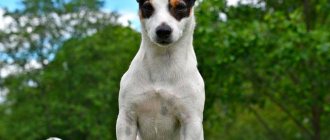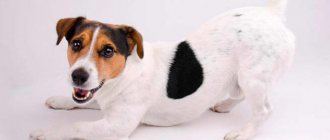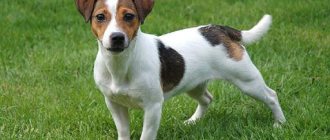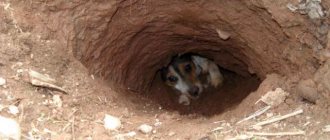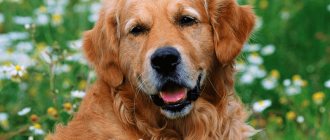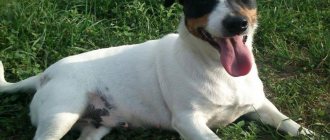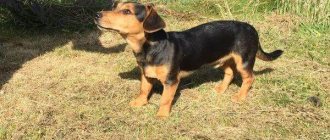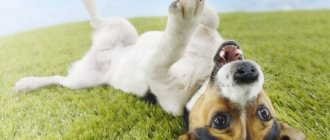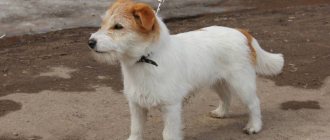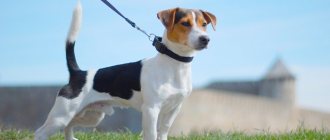One of the characteristics of the Jack Russell Terrier is its very active behavior. Probably everyone remembers the film “The Mask” - it’s not for nothing that the director chose a representative of this breed as the main animal character. And it’s difficult to say whose temperament is more violent – the dog’s or the magic mask’s. Let's find out what other features of the breed those who decide to have a Jack Russell Terrier in their home should know about.
Brief history of origin
The history of the Jack Russell Terrier breed dates back to the 19th century in Great Britain, which became the birthplace of these dogs. The Jack Russell owes its origin to Pastor John Russell, whom his friends called Jack. He was a great lover of hunting, bred fox terriers, also called fox terriers, and for a long time tried to develop the ideal dog for fox hunting.
One day while walking, the pastor saw a dog that, in his opinion, had the features of an ideal hunter, and persuaded the owner to sell it. She got the nickname Trump. All modern representatives of the Jack Russell Terrier and Parson Jack Russell Terrier breeds trace their origins to this dog.
John Russell, and then his followers, wanted to breed a burrowing dog that could race for hours with a pack of hounds and hunters on horseback. The dog must be smart in order to catch up with a meandering pack if necessary, and balanced, capable of making friends with other dogs and horses. For a long time, a breed of dogs adapted for horse-mounted fox hunting was bred, and this breed was called the Parson Jack Russell Terrier. After horse hunting fell out of fashion, breeders began to focus on breeding shorter-legged specimens suitable for hunting on foot in rocky terrain. It was only in 1971 that the breed was officially registered as the Jack Russell Terrier.
Currently, Jack Russell Terriers are rarely used as hunting dogs, but are excellent companions for active owners.
Historical reference
The origin of the breed is connected with one person - the Englishman, Reverend John (Jack) Russell, one of the founders of the English Kennel Club. At the insistence of his parents, he became a priest, but his true passion was hunting and dogs.
Do you want to get a Jack Russell Terrier?
Yes
28.57%
Has already!
71.43%
The history of the breed began with a significant meeting. John Russell, during his final year at Oxford University, noticed a bitch named Trump. She embodied the best qualities of a burrowing dog - courage, passion and small size. The dog had a white coat with dark markings on its head, a hook-shaped tail and a hard coat. She probably descended from the now extinct white terriers.
Russell bought Trump from the milkman. The bitch's exterior was far from ideal - the main disadvantage was her poor bones and muscles. Therefore, John crossed her and the offspring that came from the bitch with Fox Terriers, Irish Terriers, Borders, Scottish Cairns and Lakelands.
The official history of the breed dates back to the 1880s, when the pastor received the first dogs capable of tirelessly running along with hounds and brutally driving wild animals out of narrow holes. Their ferocity appealed not only to hunters, but also to dog fighting fans. The latter infused the pets with the blood of bulldogs.
John Russell did not take pets to shows, believing that working dogs had no place in the ring. After the death of a church minister, Arthur Heinemann began breeding the breed.
In 1914, Heinemann opened the Parson Jack Russell Terrier Club and made the first description of the breed.
Until the mid-20th century, all Jack Terriers were long-legged. The situation changed when they were crossed with Welsh Corgis and Dachshunds. This is how representatives with short limbs appeared. However, they were classified as a tribal marriage.
Only the long-legged variety, the Parson Jack Terrier, would still survive. However, in 1965 the Australians intervened. They brought several representatives to the continent and began to develop the breed.
Already in 1972, a club for “jack” fans was founded in Australia. In 1991, the Jack Russell Terrier breed standard was published, and 10 years later it was adopted by the International Canine Organization (FCI). From then on, the breed was officially divided into 2 branches.
This is how the modern type of Jack Russell appeared, or, as it is also called, the Australian Jack Russell Terrier.
Interesting facts about Jack Russell Terriers
Despite the fact that this breed originated two centuries ago, it is becoming more and more popular every year. Several interesting facts will help you learn more about this breed:
- Jack Russell Terriers, due to their light color, are susceptible to harmful sun rays and tan very quickly, so owners must stock up on sunscreen for them in the warm season.
- The height to which a Jack Russell Terrier can jump is 5 times its own height. This means that a terrier 30 cm tall is capable of jumping up 1.5 meters.
- A representative of the breed named Botie in 1982 became the first dog to make the transition from the North to the South Pole. True, he did this not alone, but with his masters - British explorers Ranulph and Ginny Fiennes.
- In 1977, a Jack Russell terrier named Vampire in Great Britain set a world record - he killed a whole ton of rats in a year.
- Representatives of the breed are among the ten dogs with the highest level of intelligence. They can draw conclusions by analyzing the data received and choose the best route. That is why these dogs can often be found in the service of customs or police.
Upbringing
Training a Jack Russell is not easy. He is independent, easily distracted, and often refuses to obey. In addition, the dog tries to dominate, is cunning and constantly tests the owner’s strength. These are the characteristics of the breed - you have to adapt to the stubborn one.
Only experienced owners are recommended to own a Jack Russell Terrier. Don't let the size deceive the future owners - it is difficult to cope with the dog, and without proper upbringing he will turn into an uncontrollable destroyer.
If a novice dog breeder definitely wants a Russell, you need to learn everything about raising the breed and, from the age of 4 months, take the puppy to classes with a dog handler.
Sports activities are desirable - agility, canicross, freestyle, frisbee. This way the Jack Russell will be able to release at least part of its inexhaustible energy.
Jack is raised gently but persistently. Attempts to dominate are suppressed, and disobedience is punished. But no screaming or spanking - the Jack Russell will be offended and, in retaliation, will do even more mischief. The main principles in training are patience, encouragement and variety.
The Jack Russell breed is described as one of the smartest - it is included in the rating of the smartest dogs. Even the training games the day before yesterday will seem boring to the dogs. You will have to come up with original activities every time.
A Jack Russell Terrier puppy needs socialization. Without it, he will bark at passers-by, throw himself at the wheels of passing cars, avoid adults and children, and run away.
Breed description, standards and appearance
The Jack Russell Terrier is a strong, robust medium-sized dog with a slightly elongated body, and according to the FCI classification it belongs to small terrier breeds. The ears of the Jack Russell Terrier are small, semi-erect, and mobile. Modern Jack Russell Terriers are short-legged dogs with pronounced muscles.
The first breed standard was formulated in Australia in 1971. The first breed club of these terriers appeared there. The FCI approved the modern breed standard only in 2001.
The exact height of representatives of the breed is not specified by the standard, but among breeders the ideal height for males is 27–30 cm, for females 24–27 cm. In adulthood, the size of female Jack Russell Terriers is always slightly smaller than the size of males.
The weight of an adult dog should be proportional to its height. A Jack Russell Terrier dog will look harmonious if for every 5 cm of its height there is 1 kg of its weight. This means that an adult who weighs 5 kg should have a height of 25 cm.
This is interesting! The maximum recorded height and weight of these dogs as adults is 40 cm and 8 kg, respectively.
Psychological picture
The Jack Russell dog is rightfully considered the most active. She is ready to play endlessly, run, jump, explore the world, swim. She needs to constantly be doing something, otherwise she will explode with energy. Within a few days, the pet can easily blaze a path near the house, simply cutting circles.
The dogs have a cheerful, mischievous character, but not without a fly in the ointment. Jacks are hunters, so they are characterized by stubbornness, independence, making their own decisions and willfulness. They are also persistent: the saying “I see the goal, I see no obstacles” applies to them.
Characteristics of the breed include some grumpiness and aggressiveness towards animals. But the dog loves people and is devoted to its owner. The Jack Russell loves spending time with his family and suffers alone.
Jack Russell Terriers can develop behavioral problems. They arise against a background of lack of attention and insufficient activity. If Jacks are not occupied mentally and physically, they will become aggressive and irritable.
Another problem is excessive loud barking. You won't be able to get rid of it, but you can train your Jack Russell to shut up on command.
Breed standard
The current FCI standard gives the following characteristics to Jack Russell Terriers:
- The skull is flat, tapering slightly from the eyes to the jaw.
- The nose is neat, black, with open and well-developed nostrils.
- The eyes are small, dark brown, almond-shaped, deep-set.
- The ears are mobile, small, hanging on cartilage. Must have V-shaped tips. Jack Russell Terriers have two types of ears: floppy or button ears.
- The jaws are powerful with strong teeth and a scissor bite.
- The neck is strong and quite long.
- The body is oblong.
- The back is strong and straight.
- The chest is deep and not wide.
- Limbs are strong and muscular.
- The paws are round, small, straight set, with elastic pads and tightly clenched toes.
- Based on the type of coat, the following varieties of the breed are distinguished: smooth-haired, wire-haired and intermediate (in English - broken, that is, broken).
- Color – white with multi-colored spots.
- The tail is set high, straight or slightly curved towards the head, thick at the base. Can be docked up to 13 cm in such a way that the remaining part is kept straight.
This is interesting! The length of the docked tail when excited should be equal to the height of the dog's ears.
Health
Both varieties can boast of good health; they live on average about 12 years. However, their immune system has its own shortcomings, expressed in a predisposition to certain genetic diseases:
- Cataract,
- Hepatitis,
- Enteritu,
- Leptospirosis.
They appear quite rarely, but are serious diseases. Under no circumstances should you try to cure them yourself. The sooner you contact a specialist, the easier and cheaper the treatment will be. To avoid these diseases in your pet, when purchasing a puppy, be sure to read the medical record of its parents. Healthy parents are more likely to have healthy children.
To read: Decorative breed with long straight hair Biro York: description and characteristics
Miniature Jack Russell Terrier
Currently, you can find advertisements for the sale of dwarf or mini Jack Russell terrier puppies.
As mentioned above, according to the standard, the height of Jack Russells, depending on gender, should be 24–30 cm, weight 5–6 kg. However, some breeders began to breed Jack Russell Terriers of the toy format - weighing no more than 3 kg. Fancier breeders of the Miniature Jack Russell Terrier claim that this is another variety of the breed, but in fact such a variety does not exist.
Indeed, sometimes puppies can be born too small, but this is usually a consequence of premature birth or inherited diseases. Therefore, when purchasing a dwarf representative of this breed, the owner must be prepared for the fact that his pet will have poorer health and will not be able to participate in exhibitions or breeding.
It is important! The lifespan of mini Jack Russells is several times less than that of standard ones.
Mating
Jack Russell Terriers are a fast maturing breed. The first heat in bitches occurs at 6-7 months.
However, the dog is not yet ready to bear and give birth to offspring. She is allowed to mate with a male only at 1.5 years of age or on her third heat.
On a “date”, Jack Russell females are usually aggressive and do not allow male dogs to approach. Matings are often carried out manually under the supervision of a dog handler. Both pets are kept on leashes, and the girl's owner secures his favorite, clasping her under the chest.
Childbirth is hassle-free and Jacks usually give birth on their own. But complications cannot be ruled out, so the veterinarian is notified of the event so that he can arrive at any time.
There are up to 6 puppies in a litter. Usually dogs give birth 3-5 times.
Coat type and color
Depending on the type of coat, representatives of the breed are divided into the following types:
- smooth-haired: the coat is short, hard, smooth, close to the body and has a developed undercoat;
- Wire-haired or long-haired shaggy Jack Russell Terriers: the hair sticks out in different directions, has a dense structure and forms eyebrows and a small beard on the muzzle;
- Brocken (intermediate coat type): the coat does not look shaggy, like that of wire-haired Jack Russell Terriers, and lies close to the body; These are hairy dogs, but they do not have a mustache or beard, and the hairs of the coat are broken in several places.
This is interesting! The coat type can be determined no earlier than two months of age, because puppies with different coat types are often born in the same litter.
According to the standard, the correct color of the Jack Russell Terrier has only three color options:
- black and white – black spots on a white background;
- white-red – red Jack Russell Terriers have spots on a white background, the color of which can vary from dark brown to red;
- tricolor - black and red spots on a white background.
In purebred individuals with any of the types of colors listed above, white cannot be less than 50% of the total area of the skin, and the spots must have a round shape and not merge with each other.
This is interesting! Solid white Jack Russell Terriers are extremely rare. Terriers with this color are disqualified from exhibitions due to lack of pigment.
Who is better?
It is very difficult to answer this question. In general, these are almost identical animals, having the same character and appearance.
In England, both varieties are equally popular, and it is extremely difficult to distinguish one breed from another by eye. If you want to get yourself a smaller dog, then choose a Jack Russell. But despite its smaller dimensions, it has no less energy.
The second significant factor in choosing a pet is its cost. These furry human friends cannot be called too dear. Jack Russells are a little cheaper; a puppy of this breed without a pedigree can be purchased for 13–20 thousand rubles. Whereas the price for Parsons starts from 20 thousand.
Character and behavior
By nature, Jack Russell Terriers are friendly and cheerful dogs. They get along well with all members of the household, without choosing a leader for themselves. They are usually friendly with other pets, but rodents can be seriously harmed by them. Sometimes Jack Russell Terrier boys show aggression towards their relatives and can even get into fights with representatives of larger breeds. Jack Russell Terriers are wary of strangers, but without aggression.
Jack Russell Terriers have a highly developed intelligence and willingly learn new commands and tricks, so even a beginner can easily cope with their training. The main thing is to be patient, praise the dog, do not raise your voice at it and, especially, do not resort to physical force. For peaceful coexistence with household members and other pets, as well as to avoid aggression towards unfamiliar people and animals, socialization of the breed should begin at a very early age.
Read this article about how to properly raise a dog.
One of the characteristics of the Jack Russell Terrier breed is a developed sense of possessiveness. These dogs are very jealous not only of their belongings, but will remain unhappy if the owner pets someone else.
An important feature of the breed is their restless nature. Jack Russell Terriers need constant attention, communication, movement or some kind of activity. Otherwise, the terrier will get bored and begin to spoil things.
Expert opinion
Leonid Rodin
Experienced dog breeder
Ask a Question
This small hunting dog often becomes the cause of major misfortunes in the house: damaged furniture and shoes, torn pillows to shreds. Unfortunately, when buying a Jack Russell Terrier, most owners do not know the characteristics of this breed and focus solely on appearance. But Russell's is deceptive. On the surface, she has a good-natured and lively nature, with attentive, kind eyes, friendly and trusting. But inside lies a real “perpetual motion machine”, which has only one true passion - unbridled movement. Therefore, the first commandment for the owner of a Jack Russell Terrier: long active walks cannot be replaced by any games in the apartment. The dog should run around enough in the park or forest. Even teaching the basic commands “Down!” and “Sit!” you cannot start without the pet expending some of its irrepressible energy. He simply will not be able to concentrate and understand what they want from him. But if he runs a little, but does not reach the point of exhaustion, Russell will be happy to do something good for his beloved owner.
Bad habits
The main reason for the bad habits of the Jack Russell Terrier is a lack of physical and mental stress. All behavioral problems of the breed can be corrected or prevented with the help of competent training and education.
The most common “bad habits” among Jack Russells:
- Excessive barking.
Representatives of the breed love to bark, moving from squealing to loud barking. Jack Russells can do this with or without reason, which can cause conflict with neighbors. Most often, your pet barks out of boredom, so you need to immediately attract its attention with clap or voice. When the dog stops barking, be sure to praise him or give him a treat.
- Stubbornness.
From the first days the puppy is at home, you need to make it clear to him who is the leader in the family. Often Jack Russell Terriers are stubborn, unwilling to obey, if the owner was unable to build a clear hierarchy from the very beginning of their relationship. These dogs can also be stubborn in order to attract the attention of their owners.
- The pursuit.
Chasing other animals, birds, bicycles and people is in the Jack Russell's blood, so you need to teach him the necessary commands, and also not let him off the leash in crowded places.
- Digging.
The origin of the representatives of the breed left its mark on them and made them good diggers. This behavior must be stopped by prohibiting the puppy from digging from early childhood, as well as distracting him with something else.
- Chewing.
Dogs of all breeds and ages have a tendency to chew on various objects. To prevent your dog from spoiling things, you need to offer him special toys or bones, and also pay him more attention.
Jack Russell Terrier and children
Jack Russell Terriers are great with children and will happily communicate with both the owner and strangers. True, you should not leave your dog alone with children under 3 years old - the dog will not tolerate strong hugs or careless handling and may snap back, scaring the child. It is important to teach your pet that the child has a routine, otherwise the dog may wake him up at the wrong time for games and communication. In families with children, these terriers spend almost all their time near them, waiting for new games and entertainment.
Socialization
With proper upbringing, Jack Russells have an excellent attitude towards children. True, they are not suitable for children under 8-10 years old. Dogs love to be worn and will not tolerate having their tail or ears pulled. They need a friend as eccentric as themselves.
Jack Russell Terriers and school-aged children make great company. However, you cannot let them go for walks alone or trust a child to raise the dog. Having become interested in something, the pet will break off the leash. But not every adult can cope with Jack training.
The pet is cool and wary towards strangers. But once he gets to know the person better, he will happily play with him and let himself be stroked.
Jack is intolerant of other animals. He is aggressive towards male dogs. If a terrier lives with another dog, he will become the head of the hierarchy.
Jackies don't like cats. Some dogs get along with mustachioed dogs if both have space and their own secluded places in the house. But birds and rodents are prey for dogs. They will always haunt them. And education is powerless here.
Care and maintenance
Jack Russell Terriers are an unpretentious breed of dog. They can live in a country house or in an apartment without any problems. However, with the latter option, you need to provide your pet with sufficient physical activity. These active terriers need frequent and long walks - about an hour twice a day, keeping them busy with dog games.
Caring for the coat of representatives of the breed is not difficult - smooth-haired individuals only need to be combed every week with a special rubber mitten, while pets with other types of coat need to be trimmed every three months. The coat of these terriers has the ability to self-clean, so they do not need to be bathed often - it is advisable to do this 3-4 times a year, and also before shows.
It is important! Female Jack Russell Terriers must be bathed after the end of their heat.
For prevention, you can wipe your eyes with a cotton pad soaked in boiled warm water. Teeth should be periodically brushed with toothpastes, and the dog should also be given special bones. Ears should be checked weekly for dirt and cleaned with a cotton pad soaked in a special lotion. Nails need to be trimmed monthly with clippers.
Read more about “How to properly care for the breed and maintain a Jack Russell Terrier.”
To choose a Jack Russell Terrier puppy, you need to study the documents of its parents and observe their behavior. When choosing a puppy, it is very important to pay attention to its appearance and behavior - the baby must be healthy and active. It is advisable to choose a dog from a specialized kennel or from an experienced breeder who cares about the gene pool and education of his pets.
The price of a purebred puppy with all documents and pedigree will be at least 35,000 rubles. Kids without a pedigree will cost 10,000-15,000 rubles. The price of a puppy is greatly influenced by the city of purchase: for example, in Moscow and St. Petersburg they will cost several times more than in other Russian cities.
How to choose a puppy
Russell is a popular breed. Many breeders sell breeding stock without documents and practice inbreeding - inbreeding.
To get a healthy puppy, you need:
- find out what mom and dad look like - they watch the dogs live;
- look at the kids - they should be moderately well-fed, stand firmly on their paws, have clean eyes and ears, be wary, but not aggressive, towards strangers;
- ask for photographs of dogs from previous litters, find out whether the breeder’s “children” became champions;
- inspect the nursery - dirt, dampness, cramped premises indicate poor maintenance.
In addition, they learn everything about the breed, visit exhibitions, and learn from breeders and dog handlers about possible difficulties in keeping and training.
Caring for puppies
Jack Russells usually give birth to 3–5 puppies in a litter, but some females give birth to 6 puppies. Newborn puppies feed on their mother's milk for the first month of life. After reaching this age, they need to gradually introduce complementary foods.
Jack Russell Terrier weight and height table by month
The age when a dog stops growing is different for each breed. Jack Russells typically grow until they are 11 to 12 months old. To properly assess your puppy's development, you need to carefully monitor its weight and height in the first year of life: use the table below for this:
| Age, months | Weight, kg | Height, cm |
| 1 | 0,7–1 | 8–9 |
| 2 | 2 | 10 |
| 3 | 2,5–3 | 11 |
| 4 | 4 | 12 |
| 5 | 4,1 | 13 |
| 6 | 4,3 | 15 |
| 7 | 4,5 | 17 |
| 8 | 4,6 | 19 |
| 9 | 4,7 | 20 |
| 10 | 4,8 | 22 |
| 11–12 | 5–6 | 25–30 |
It is important! The parameters indicated in the table and the actual dimensions of the puppy may differ by approximately 0.5 cm or several grams. If the height or weight of a Jack Russell Terrier is significantly below the norm, it is imperative to consult a veterinarian.
From one and a half to 4 months, babies grow very actively, gaining height and weight, so their growing bodies require a large amount of nutritious food. If during this period the baby moved to a new home, at first it is advisable to feed the puppy the food that the breeder gave him. After the baby gets comfortable, you can change the type of feeding. If the owner chooses a natural method of feeding at this age, it is necessary to gradually introduce complementary foods into the puppies’ diet.
The Jack Russell Terrier continues to grow its body and internal organs for 4 months. At this age, the puppy's baby teeth fall out and permanent teeth grow, and fur formation also occurs. From 4 to 6 months, the foods in the diet remain the same, but the number of feedings decreases and the volume of portions increases.
You can find out more about your dog’s diet in the article “What to feed your Jack Russell Terrier.”
From 6 to 12 months of age, puppies grow less - at this time their bones become stronger and muscle mass increases, so the calorie content and volume of food can be reduced by reducing the amount of cereal given to the pet.
Feeding table for Jack Russell by month in the first life with a daily menu:
| Age, months | Menu for the day | Number of feedings |
| 0–1 | Mother's milk | 7–8 |
| 1–2 | Milk, soaked dry food, broth | 7 |
| 2–3 | Boiled lean meats, cereals, vegetables, fruits, dairy products | 6 |
| 4–5 | Meat, cereals, vegetables, dairy products, fruits | 4 |
| 6–12 | Meat, fish, cereals, vegetables, dairy products, boiled egg yolk, fruits | 3 |
It is important! After the dog reaches one year of age, it needs to be switched to 2 meals a day.
Caring for a Jack Russell Terrier puppy from the moment it arrives in the house should be carried out according to certain rules:
- The baby’s place should be away from heat sources and drafts;
- it is necessary to purchase a sufficient number of toys for the puppy, which will be located next to his bed, as well as bowls, a leash, a muzzle, and a massage mitten;
- You can only walk your Jack Russell Terrier puppy on a leash;
- up to a year old, small Jack Russells should not go down stairs due to the risk of damage to their elbow joints;
- puppies can be walked only after they have received all the necessary vaccinations;
- you should not wake the baby unless necessary, since sleep is important for the formation of his nervous system;
- Until 5 months, Jack Russell puppies should not be left alone - at this age they find it difficult to tolerate loneliness, perceiving it as punishment.
It is important! You should not play games like tug-of-war with puppies - this can lead to the formation of malocclusions.
What should the diet be like?
In the first few weeks that you have a puppy, you should feed it the same as the breeder fed it, gradually transitioning it to the desired diet .
If you plan to feed your Jack Russell with industrial food in the future, then choose premium or super-premium products.
If you want to feed your pet natural food, then begin to gradually introduce the following products into his diet:
- meat;
- fish;
- dairy products;
- cereals;
- vegetables and fruits;
- eggs.
For 1 kg of puppy, 20-30 g of meat per day is required.
Ideal meat choices include beef, turkey and chicken breast. Shred the beef before serving, but you will have to cook the chicken and turkey.
A couple of times a week you should give fish, but only sea or ocean fish. Before serving, boil and remove bones.
At first, small puppies should replace cow's milk with 10% cream diluted with water. Calcined cottage cheese can also be an alternative. It should be given several times a week, 30-50 g.
You can start your first complementary foods with buckwheat and rice porridges.
The Jack Russell digests carrots, beets, zucchini and pumpkin best. During the season, you can add a little greenery to them.
You can give an apple as a fruit. You can give other fruits if the puppy is interested, but you should avoid feeding citrus fruits .
Sometimes give your puppy an egg omelet, but no more than 1-2 times a week.
Vaccinations and susceptibility to disease
The Jack Russell Terrier is one of the ten longest-living dogs, their life expectancy is on average 14–16 years.
They are considered a breed with good health, but are still susceptible to some “breed” diseases:
- allergy;
- hip dysplasia;
- diabetes;
- cardiovascular diseases;
- cataract;
- dislocation of the kneecap;
- Perthes disease (damage to the head of the femur);
- congenital deafness.
In addition to all grooming procedures, it is necessary to vaccinate representatives of the breed from a very early age. Newborn Jack Russell Terrier puppies gain immunity from their mother's milk, but this disappears by about two months of age. At this time, the puppy needs to have its first vaccination, before which mandatory deworming is carried out.
It is important! Before administering the vaccination, the veterinarian must provide the owner with information about the name of the vaccine and its expiration date.
Vaccinations for puppies of this breed are carried out strictly according to schedule. The Jack Russell Terrier vaccination table by age will make life easier for an inexperienced dog breeder:
| Age | Disease |
| 8–9 weeks | Canine distemper (distemper), leptospirosis, hepatitis, parainfluenza, parvovirus enteritis |
| 12–14 weeks | Canine distemper, leptospirosis, hepatitis, parainfluenza, parvovirus enteritis + rabies |
| 12 months | Canine distemper, leptospirosis, hepatitis, parainfluenza, parvovirus enteritis + rabies |
In the future, the pet is vaccinated annually with complex vaccines against rabies and other deadly infections.
First vaccinations
At 21 days, the puppy and mother are dewormed. This is usually done with a suspension of Drontal Junior, Pirantel and other drugs.
At 4-6 weeks they are vaccinated against distemper and parvovirus enteritis.
At 3-9 weeks the following vaccinations are given:
- repeatedly from plague and parvovirus enteritis;
- from hepatitis;
- from parainfluenza;
- from leptospirosis.
At 12 weeks, revaccination against distemper, hepatitis, parvovirus enteritis, and leptospirosis is carried out. Vaccination against rabies is carried out.
At 6-8 months after changing teeth, revaccination against distemper, hepatitis, parvovirus enteritis and leptospirosis is carried out.
The main pros and cons of the breed
Owners of these terriers, in addition to the bad habits of their pets, may encounter the following problems of the Jack Russell Terrier breed. But undoubtedly, this breed has many more advantages.
| pros | Minuses |
| Possibility to be kept in a small apartment due to its compact size | The need for active and long walks |
| Developed intelligence | Heavy shedding in smooth-haired individuals |
| Excellent learning ability | Male Jack Russell Terriers are often aggressive towards other dogs |
| Unpretentiousness | |
| Good security qualities |
This is interesting! Jack Russell Terriers are often used in canis therapy - they help improve the condition of children with autism, cerebral palsy and other disorders.
The Jack Russell Terrier, despite all its bad habits, will definitely become the main favorite of the whole family and the best friend of children. The owners only need, in addition to standard care, to pay more attention to their pet, often playing, walking and simply communicating with him.
Application
The Jack was originally bred as a hunting dog. Although today he has retrained as a companion, his instincts remain. The pet chases animals, digs holes and often gets into trouble because of curiosity.
Jack Russells are also used in canistherapy - the treatment of children with developmental delays with the help of dogs. The cheerfulness and hyperactivity of dogs helps sick children improve their social skills.
Jack is suitable only for active people. A person who works from morning to night or prefers to relax at home should take a closer look at other breeds.
